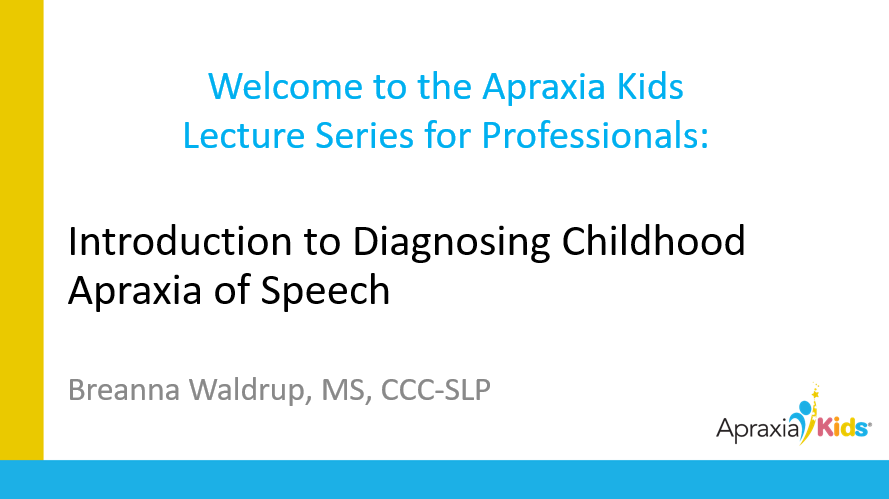
30 Jan Introduction to Diagnosing Childhood Apraxia of Speech
Course Abstract:
This session defined childhood apraxia of speech (CAS) and outlined the characteristics that are most likely to distinguish CAS from other speech sound disorders. Current best practices and key assessment components for diagnosing CAS were discussed. Additional CAS resources were also shared.
Presented By:
Breanna Waldrup, MS, CCC-SLP, Recognized by Apraxia Kids for Advanced Training and Expertise in Childhood Apraxia of Speech
Target Audience:
Professionals
This course is offered for 0.10 ASHA CEUs (Introductory Level, Professional Area)
Learning Objectives:
- List 3-5 discriminative characteristics of CAS.
- Name 2 key assessment components in a CAS evaluation.
Agenda:
- Presentation (60 Minutes)
- Define childhood apraxia of speech (CAS)
- Explore characteristics most likely to distinguish CAS from other speech sound disorders
- Review best practice and key assessment components for diagnosing CAS
- Receive resources to learn more about CAS
- Discussion (15 Minutes)
- Speakers, facilitators, and attendees discussed the session, shared resources and ideas, and asked/answered questions.
Course Abstract:
This session defined childhood apraxia of speech (CAS) and outlined the characteristics that are most likely to distinguish CAS from other speech sound disorders. Current best practices and key assessment components for diagnosing CAS were discussed. Additional CAS resources were also shared.
Presented By:
Breanna Waldrup, MS, CCC-SLP, Recognized by Apraxia Kids for Advanced Training and Expertise in Childhood Apraxia of Speech
Target Audience:
Professionals
This course is offered for 0.10 ASHA CEUs (Introductory Level, Professional Area)
Learning Objectives:
- List 3-5 discriminative characteristics of CAS.
- Name 2 key assessment components in a CAS evaluation.
Agenda:
- Presentation (60 Minutes)
- Define childhood apraxia of speech (CAS)
- Explore characteristics most likely to distinguish CAS from other speech sound disorders
- Review best practice and key assessment components for diagnosing CAS
- Receive resources to learn more about CAS
- Discussion (15 Minutes)
- Speakers, facilitators, and attendees discussed the session, shared resources and ideas, and asked/answered questions.
Credentials:
Hours of Operation:
Treatment locations:
Address:
,
Phone:
Email:
Overall Treatment Approach:
Percent of CAS cases:
Parent Involvement:
Community Involvement:
Professional consultation/collaboration:
Min Age Treated:
Max Age Treated:
Insurance Accepted:



